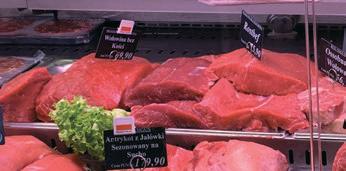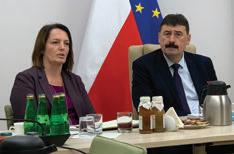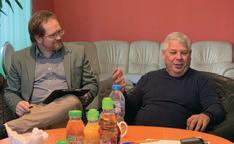
5 minute read
From the Editor
IN THE NEWS
Poland’s Meat Industry Reaches Out to the World
AARON HAND | EDITOR-IN-CHIEF
ON A TRIP sponsored by the Union of Producers and Employers of Meat Industry (UPEMI), a group of U.S. and Canadian food industry journalists visited Poland to learn about the quality of European meats. Through a series of interviews with trade and government o cials, meat processors, chefs, and restaurateurs, we learned not only of the desire to reach North American markets with high-quality beef, pork, and chicken, but also the e orts being taken to ready products for export around the world.
Poland is the No. 1 poultry producer in Europe, but it has had di culty getting the go-ahead to export poultry to the U.S. since 2014. That hurdle was fi nally overcome in late October, according to Polish delegates we met with in November. “The U.S. veterinary services recognizing the equivalence of the Polish supervision system for poultry meat production with the American system was a huge success,” says Katarzyna Piskorz, deputy chief veterinarian for Poland, also pointing out some superior aspects of Polish poultry. “In the U.S., they’re allowed to add certain disinfectants when processing. That’s not allowed in the EU. We would be ecological 100%.”
Beef and pork
But it was primarily beef and pork that the visit was focused on—touring a beef slaughterhouse and processing facility; a meat processing plant focused largely on pork; butcher stores; and several restaurants with renowned chefs serving up some of the best the country has to o er.
The EU exported more than $220 million of pork and close to $44 million of beef to the U.S. in 2020, according to the European Commission. The U.S. is Poland’s primary market for pork exports. However, beef from Poland is
Befsztyk is a well-known butcher shop in Poland. Opting for quality over price, the shop sells meats from Poland and around the world.
Senate Confi rms New FDA Chief
Dr. Robert Cali has been chosen to lead the FDA again. He previously served as FDA commissioner in the last year of the Obama administration. The agency did not have a permanent leader for 13 months.
USDA Committed to Enhancing American Food Supply Chain
The USDA is making up to $215 million available in grants and other support to expand meat and poultry processing options, strengthen the food supply chain, and create jobs and economic opportunities in rural areas.
Nestlé’s New Research Institute
Based in state-ofthe-art facilities in Lausanne, Switzerland, the Nestlé Institute of Agricultural Sciences will strengthen Nestlé’s agricultural science expertise to help it achieve net zero and transition to a regenerative food system.
Microsoft Selects Land O’Lakes/ Truterra CO2 Removal Project
Truterra, Land O’Lakes’ sustainability business, will work with its agricultural retailer network and farmer-customers to generate carbon assets for sale to Microsoft.
U.S. Avian Infl uenza Numbers Continue to Grow
As of March 8, the virus had been identifi ed in fl ocks in 12 states, stoking fears of an outbreak comparable to that of 2015, which prompted the depopulation of 43 million chickens and 7.4 million turkeys.
s Katarzyna Piskorz, Poland’s deputy chief veterinarian, and Ryszard Bartosik, deputy minister of agriculture and rural development, meet with U.S. and Canadian food journalists.
The processing plants

s With the help of an interpreter, Waldemar Podniesiński (right), Mokobody’s president, explains the challenges that beef producers face in Poland.
not currently exported to the U.S. That is a situation that the country aims to change with its Meat With European Quality campaign.
The recent win for Poland’s poultry industry in the U.S. “gives hope for the aforementioned prompt initiation of beef exports to the United States, as well as expansion in the supply of a catalogue of pork products,” Piskorz notes. “For beef, we’re hoping it won’t take so long as eight years.”
Pricing its meat lower than some other parts of Europe while also still adhering to European safety regulations puts Poland in a competitive position in other markets. “The significant potential of Polish agriculture consists of well-developed plant and animal production, the highest standards of quality and food safety, which go hand in hand with competitive prices,” says Ryszard Bartosik, deputy minister of agriculture and rural development.
Sustainabiilty
Wieslaw Różański, president of UPEMI, attributes the quality of European meats to animal genetics, wellbeing, transport, and slaughter. He also discusses the e orts being made in Poland toward more sustainable practices within the meat industry. “Beginning next year, Poland will require farmers to certify their operations as zero emission,” he says.
Poland’s meat producing industry maintains sustainability guidelines through the whole production chain, Różański says. “There has been an industry move to more renewable energy sources, biodegradable packaging, lower-emission transport, and other best practices,” he notes.
It’s an expensive e ort that will take a number of years, he says. For farmers, the most direct route is to use solar panels to capture the renewable energy. Some might aim for bio-gas plants, using manure as fuel. “There are basic practices that will result in farmers getting to carbon-free.”
As part of our tour, we visited two meat processing plants. The first, Zakłady Mięsne Mokobody, was originally established in 1989 and then completely rebuilt and modernized in 2004 and established as an LLC, with its current name, in 2008. “There was a very big investment made in our operation just before Poland joined the European Union in 2004,” says Waldemar Podniesiński, Mokobody’s president. “Our plant was rebuilt from the ground up over a seven-month period. We entered production in 2004 as a fully upgraded European Union slaughterhouse facility.”
Podniesiński made the decision to upgrade to EU requirements rather than become obsolete— likening the decision to keeping a knife sharp in the slaughterhouse rather than moving forward with a dull knife. “If we didn’t upgrade our technology then, we would not be here today because the plant would simply be obsolete now,” he says.
Mokobody has been focused solely on beef since 2005, when it phased out pork slaughter for economic reasons. “It was not profitable, so we decided to focus on beef,” Podniesiński says.
That beef, he insists, is a higher-quality beef. He points to the way the animals are fed and the way they are cared for. Dismissing questions about the use of growth hormones or antibiotics, he says, “Here in Poland, we use natural feed like straw, maize, things like that. Everything is done for the animals to make them comfortable.”
Cultivating exports
Within the beef market, Mokobody has put a strong emphasis on its certification within Islamic markets for Halal beef, enabling it to sell its product to several markets outside of Poland. “We’re certified to export to Dubai, Uzbekistan, Turkey, Indonesia, Japan, Hong Kong, and others. So this is our main focus right now,” Podniesiński says.









